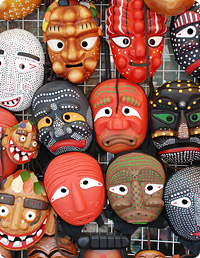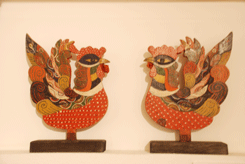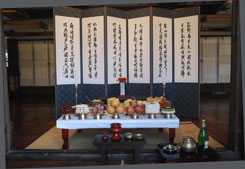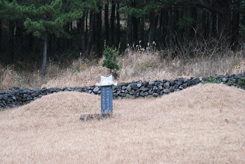Life
Funeral
Ancestor worship comprised the bare bones of social structure. Death was mourned in elaborate rituals over 3 to 7 days. When a parent passed away, the children considered it their duty to do their best in observing the three-year mourning period as prescribed by Confucian ethical code. The funeral procession featured a colorful bier, and some human figurines and everyday objects were buried in the tomb to accompany the deceased in the next life. Throughout the mourning period meals were offered at the family altar every morning and evening. Some lived in a grass hut built near their parents' grave during this period. After a funeral is completed, a spirit shrine called Binso is erected at the home of the deceased. There his or her soul is said to reside for the duration of the formal mourning period. During this period interaction with the deceased is modeled closely on behaviors appropriate toward living elderly parents. For example, portions of daily meals are placed at the spirit shrine, and visitors to the home are brought to greet the deceased. The chief mourner dressed in yellow-white, stands at the right of the guest facing north. To express his sorrow, he cries to which the visitor responds with cries. The mourner carries a bamboo stick by his father's funeral, whereas willow stick for this mother's.
Bier
Traditionally, the biers were used for conveying the corpse to the burial site, resembling palanquins having long poles on both sides to be shouldered by 12 or 24 pallbearers. In traditional Korean funeral rites, two carriers stand out in a funeral procession; the coffin carrier called Sangyeo and the tablet carrier called Yeongyeo. The Sangyeo comes in different styles and sizes. Most villages had such a bier for common use. It was designed to be disassembled for storage in a house removed a short distance from the neighborhood. The funeral carriers and equipment are shared and owned by villagers in rural Korea. Some families decorate Sangyeo with paper flowers of several kinds.
Graveyard
Geomantic principles are frequently referred to in selecting auspicious housing lots or graveyards for ancestors. A geomancer's choice for a burial spot should guarantee harmony with the four elements of dragon, pit, wind and water. The dragon in geomantic science denotes a mountain, just as dragon vein indicates the mountainous flow from the main center to the pit for burial. Wind is the topographic features embracing auspicious shapes. The Fengsui will carefully consider individual ecological elements, such as geology, climate, water, soil, topography, slope, vegetation, and wildlife, in choice of a graveyard. With seasonal changes, solar and lunar forces and the principle of five elements, geomantic science became an active force in the lives of Koreans. A second basic principle is that these spirits affect human life, which will in turn respond to these spirits. With the Yin and Yang theory of negative and positive forces, auspicious spirits, which brought a prosperous and happy life, along with evil spirits, which brought calamity, became an integral aspect of both the living and the dead. In short an idea site for tombs is a location where the mountain sprits focus into one point, where slopes block the winds, and where the water is in the favorable place.
Ancestral rites
Koreans have traditionally believed that the soul separates from the body at the time of death. The soul does not disappear, but roams the earth for a period of months or even years, causing all manner of mischief. A luckless family might blame their misfortunes on a restless ancestor spirit. To placate the dead and ensure peace, an ancestral shrine was commonly built, where the family could keep in communication with the ancestor and lead him--or her--to peace through the help of a Shaman. Afterward, descendants would regularly visit the grave to keep the soul informed of his living family.
Filial piety was practiced not only for living parents but ancestors as well. Solemn rites were performed to pay respect to ancestors of up to four generations on the eve of their dearth anniversaries and holidays such as New Year's Day and the Chuseok harvest festival. Memorial tablets of these ancestors were kept at the family shrine for the rites, through which the ancestors had communion with their descendants. Those who did not have family shrines placed the memorial tablets in an alcove in the house or performed the rites before a picture of an ancestral shrine.









